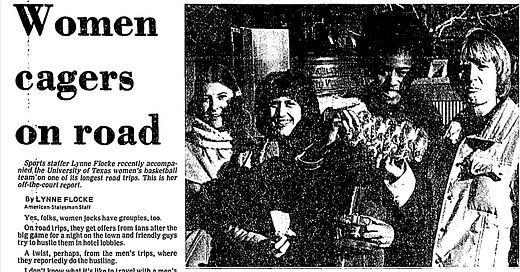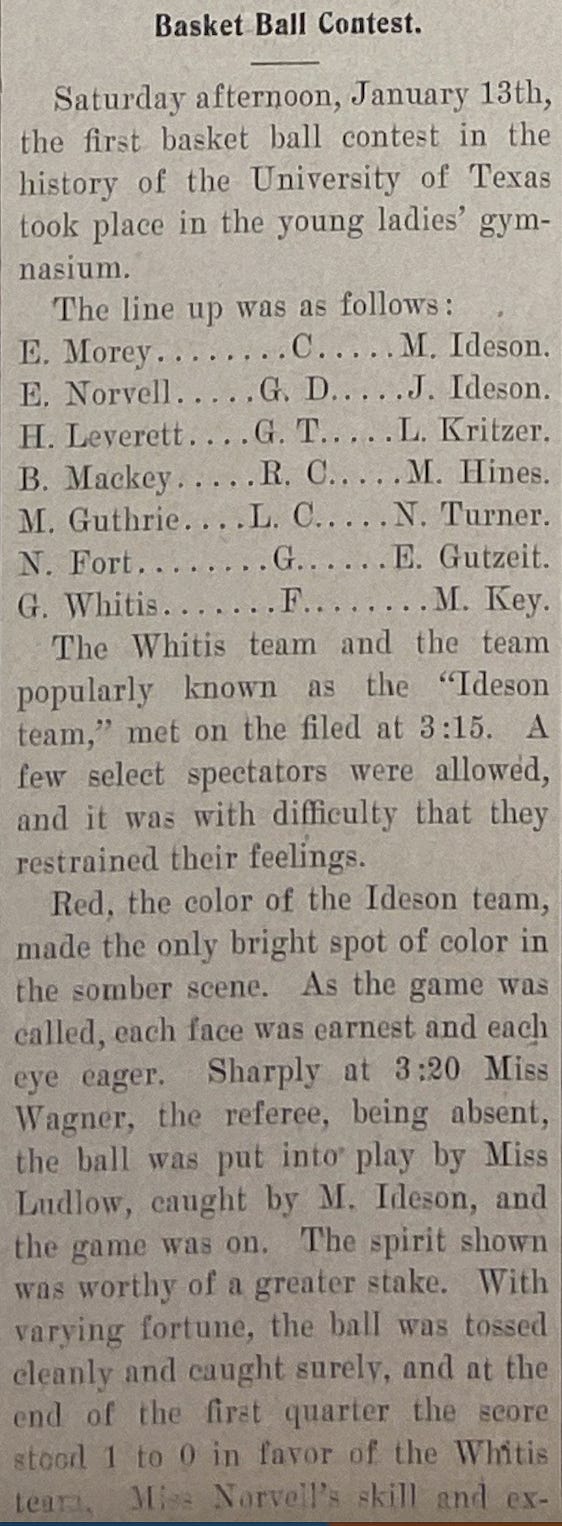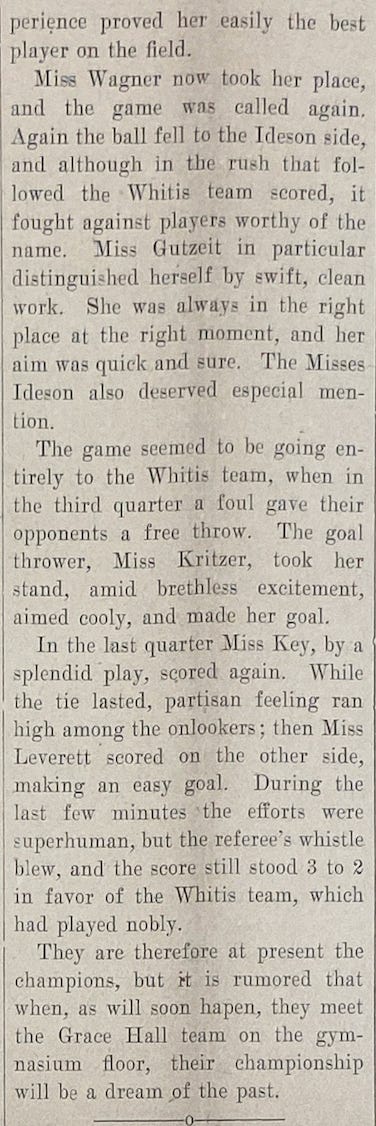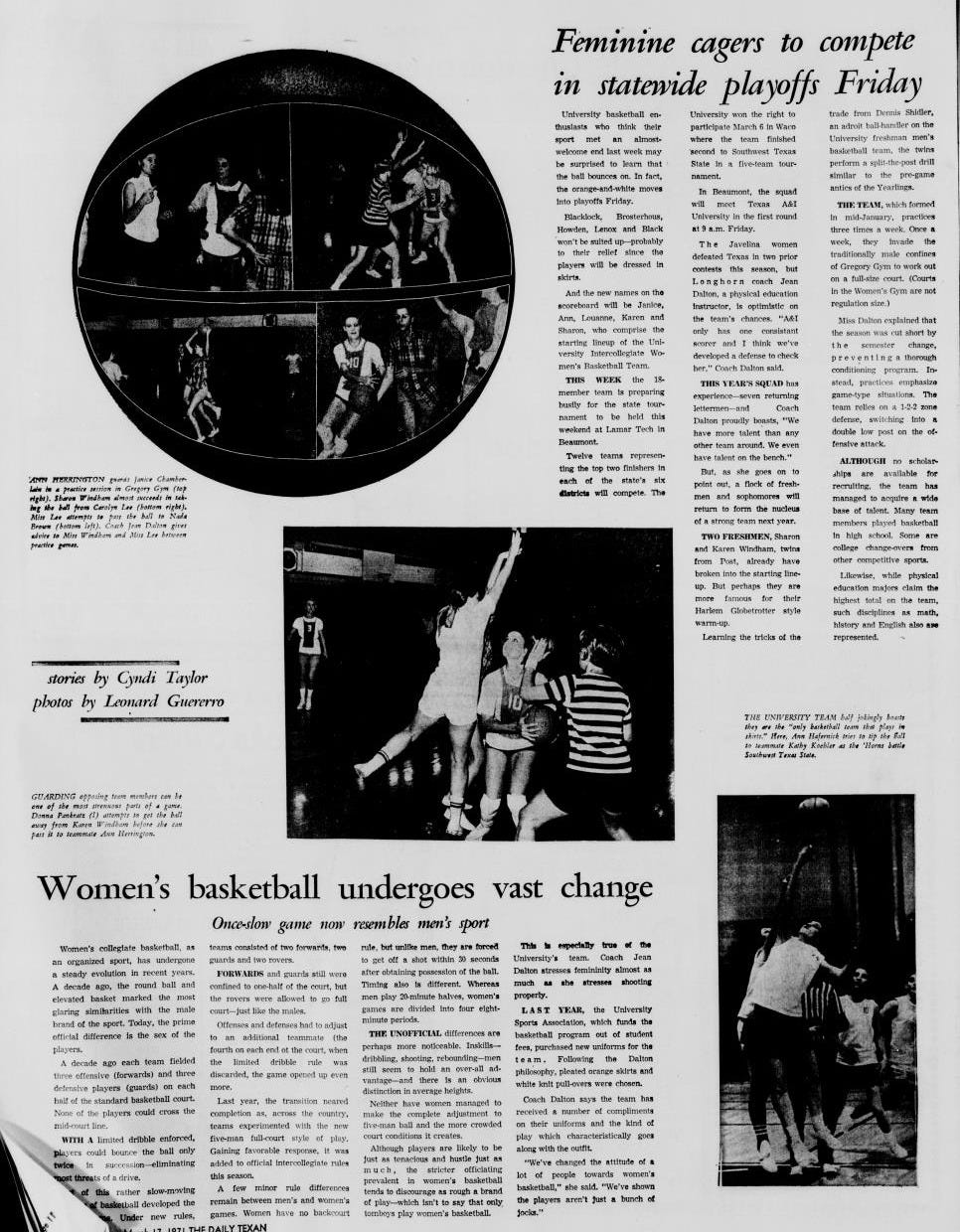Inside the remarkable 125-year history of Texas women's basketball
"It is, in short, the story of women's sports."
Hi, friends. Lindsay here. Today we have a VERY special treat. In an extraordinary twist of fate, Jessica Luther, my dear friend and Burn It All Down co-host, is defending her dissertation on the history of women’s basketball at the University of Texas today. Like, today, Friday, April 4. Like today, Friday, April 4, the same day that Texas women’s basketball will play South Carolina in its first Final Four since 2003!!
Because I am diabolical, I reached out to Jessica *yesterday,* the day before her dissertation defense, and asked if she had any quick thoughts/reflections/facts about Texas women’s basketball that she’d be willing to share with Power Plays readers, to give us all a bit more context about what this day means and how we got here. Now, I’m not an academic myself, but people have told me that the day before the defense is a pretty stressful day! And yet, instead of immediately blocking me from every app she owns, she said “yes” and sent me over five wonderful archival clips and accompanying insights! Aren’t we lucky?
This was so much fun to read through and compile for you all, and I hope you all take some time to digest it as you get ready for the games tonight.
But first, here is the complete description of Jessica’s dissertation:
My dissertation is about the University of Texas women's basketball team in the 1970s, specifically the impact of two different types of civil rights legal actions -- desexigration (the term used in the 1970s) and desegregation -- on women's athletics, especially on Black coaches and players. At UT, desexigration led to a separate and distinct women's athletics department that forced women to find resources and financing outside of the established men's infrastructure and which led to them dedicating their attention to gender inequality often at the expense of racial inequality, whereas desegregation demanded the assimilation of students and faculty of color into the white status quo, erasing their needs and desires on a campus, in a city, and in a state that had historically discriminated against them, thus ignoring their struggles in an often-hostile environment. Both of these responses have had long tentacles and ripples that women's sports is still grappling with today. As I write at the end of the introduction to my dissertation, the women's basketball team at the University of Texas in the 1970s is a microcosm of the ways that women's sports have succeeded and failed. It is, in short, the story of women's sports.
Doesn’t that sound absolutely INCREDIBLE??
Now, without further adieu, here is the soon-to-be Dr. Luther:
Having recently written over 100,000 words about the UT women's basketball program, I am having a lot of thoughts and feelings about the team making their first Final Four appearance since 2003. I'm mainly just really pumped about this.
Here are some fun nuggets about the history of women's ball at UT:
Women played basketball at UT before men did, starting in 1900!
The very first basketball game ever played at UT was on January 13, 1900, between two women's teams. The final score was 3-2, spectators remained quiet during the match (those were the rules of decorum at the time) and they were only women (men would not be allowed to watch women play basketball at UT for decades), and it would probably have not looked much like the basketball we are used to today (much less vigorous, I'm not sure if they had any dribbling yet, women had to stay in specific parts of the court, depending on what rules they were using at the time). But still, the women were first at UT.
Here’s a fun archival clip about said game from The Ranger on January 15, 1900.
In fact, in 1909, the student newspaper lamented basketball as a ‘girls only’ sport!
The Texas men didn't get around to playing basketball until 1906 and in 1909, the student paper had a column where the author lamented the lack of enthusiasm for men's basketball on campus and wrote, "we know that such a game is considered to be for girls only" (what a telling phrase!) and then dissed the women's game, "but you see or get into a game where the players are really athletes and experienced and your mind will be suddenly changed into the realization it is not child's play." Ouch, 1909 misogynist! Reminds me of how those of us who have long supported women's basketball (and sports) have said, "You just have to watch and you'll be hooked!"! Anyway, in March Madness this year, the game was for Longhorn women only!
Here’s an article from the Daily Texan on January 16, 1909:
Women were pushing Texas for an official team at least as early as 1966!
Women at UT were pushing for varsity athletics (I use that word because that was what they used at the time to differentiate intercollegiate athletics from intramurals) since at least 1966, years before Title IX. In 1973, as administrators at UT were fighting over how they would establish and fund the women's athletics department, which officially started in 1974, Betty Thompson, who was in charge of women's athletics at Texas from 1968-1975, wrote a report that had a short history of women's varsity sports at UT in it.
She wrote, "Two groups of students requested assistance in the formation of teams in basketball and volleyball for the express purpose of competing on an extramural basis. These teams were to be seasonal in nature and team membership was to be based on try-outs (i.e. skill). This took place in 1966–67." That was the beginning of the push for intercollegiate basketball at UT.
The first modern women’s basketball game at Texas was played in 1971, before Title IX
The first intercollegiate women's basketball game in the modern era took place in February 1971, again, before Title IX. They participated in a tournament hosted by Southwest Texas State University (now Texas State). By March 1971, the student paper had a full page about the "feminine cagers" before they set off to compete at state. In the write up at the bottom of the page, it compares men's and women's basketball, and also discusses the femininity the women were forced to participate in.
"Following the Dalton philosophy [referring to the head coach, Jean Dalton], pleated orange skirts and white knit pull-overs were chosen" as the new uniforms that year. I interviewed Jo Ann Holmes, who was a freshman on the team in the 1972–1973 season, and she told me that when she was home over Christmas that year, her high school coach "started cracking up, laughing her head off," when Holmes told her she was going to play on the team. Her coach explained her response: “‘All I can see is the uniforms they used to wear.’ The girls' uniforms were skirts. And she thought that was the funniest thing in the world,” Holmes says. In response, Holmes told her “They're not now.”
Here’s a clip from the Daily Texan on March 17, 1971:
The team was extremely under-resourced in its early days
The final thing I want to share is a 1978 article about the women traveling east to play a handful of top-ranked teams. It was the second time they'd done this. When Jody Conradt started in 1976, she and Donna Lopiano, the school's first women's athletics director, decided the way to get UT on the basketball map was to travel and make news. Lynne Flocke from the local paper embedded with them and wrote a bunch of articles, including this recap article.
I love it because of the picture in which Retha Swindell, the first Black female varsity athlete at UT, is holding a pretzel in front of the Liberty Bell flanked by teammates. And I love all the details, especially about all their groupies and the pushing a van through snow to avoid paying repair fees. To read about what the team used to experience because of the lack of resources and financial support and then to think about where they are now, it's really something.
















